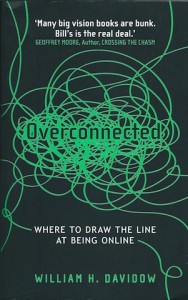The one-sentence summary
In overconnected situations, institutions change so fast that the environment can’t cope, or vice versa, so we need to know where to draw the line online.
WHAT THE BOOK SAYS 
- This book explains where to draw the line at being online.
- The author is a Silicon Valley venture capitalist and former executive at Intel, and claims that the consequences of an overconnected world cannot be ignored, because they have unexpected distorting effects on economics, politics, international relations and individual lives.
- He identifies four distinct levels of connection:
1. Underconnected: isolated ancient civilizations, primitive cultures and a few undeveloped countries. Change is slow or non-existent, and any interaction with an outside environment leads to a big shock, or sometimes even complete destruction, followed by a dangerous cultural lag.
2. Interconnected: where the system changes gradually, businesses, governments, and economic systems can keep pace. There is little or no cultural lag, and each element catches up fast enough with the others.
3. Highly connected: a critical level of connectivity that appears to make everything go right. This is the optimum state, so long as adjustments to change come fast enough to keep up. If not…
4. Overconnected: institutions change so fast that the environment can’t cope, or vice versa. This is where it all goes wrong (cf. Iceland, or any financial crash)
- He says that although we cannot turn the clock back and undo ubiquitous connectivity, we can be more cautious and exercise greater forethought with regard to the systems we build in the future.
WHAT’S GOOD ABOUT IT
- Wigner’s equation shows that under certain conditions particular types of large, interconnected physical systems will always be unstable. To the layman, this essentially occurs when everything is connected to everything else.
- Examples include small power cuts: (if isolated, these cause little problem, but have been known to trip massive blackouts); or the Three Mile Island nuclear reactor disaster which was started by a tiny amount of water leakage and then compounded by scores on tiny (wrong) decisions.
- In engineering terms, a positive feedback loop means that change reinforces or adds to change, and that can often be bad, leading to a vulnerability sequence.
- Society is filled with interconnections that can have the same effect even if they are not internet based.
WHAT YOU HAVE TO WATCH
- It is more of a history of world interconnections than a handbook for solving overconnectivity. He merely suggests acknowledging overconnectivity. reducing levels of positive feedback, and designing more robust systems.
